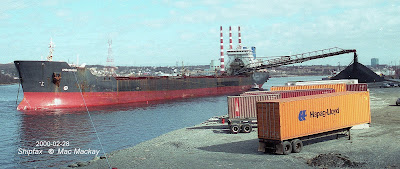The Richmond Terminals area, Piers 9 to 9C, at the extreme north end of the harbour, are not highly active parts of the waterfront these days. Of the three large transit sheds, only one remains in use as such. The Pier 9 shed (once a Volvo assembly plant) is now used as a warehouse by Halifax Shipyard. The Pier 9A shed is now the home to IT International Telecom and does see some ships transferring specialized cargo including cable or undergoing refit.
Only the Pier 9B shed is used for freight. Lately it has been used to transfer cargo from rail car to container (mostly paper products as far as I can tell) and stainless steel wire for tire manufacturing.
The extra height boxcar is dedicated to paper transport, and is a rare Golden West reporting mark for Southern Pacific. Note the three Nova Scotia Power smoke stacks peeking above the roof. They are from the company's Tufts Cove generating station, which now burns natural gas, but was built for coal and oil
The open Pier 9C was recently rebuilt and provides a hard surfaced open area, which has has seen a variety of uses for project or bulk cargoes such as coal, and is now storing salt (see recent posts), but was also used as an offshore oil and gas service base.
Although the entire Pier 9B, 9C area may look underutlized, it is a useful resource for odd cargoes, and a good place to tie up ships for repairs or short term layups. Oceanex Sanderling was there a week ago for repairs.
There is also the rarely used "Marine Terminal" at Pier 9 where a pipeline runs up to Wilson's Fuels storage tanks on Barrington Street. Originally Petrofina tanks, they have been used infrequently recently to receive fuel from Newfoundland, and to refuel some ships. Wilson's have sold the terminal and storage facility to Couche-Tard along with its Wilson's gas stations in the region, so it remains to be seen what the future will bring for the terminal.
Hother Isle was built in 1956 by Howaldswerke, Hamburg as the general cargo ship Christiane, and in 1969 was lengthened 12m and converted to carry containers. It lasted until 1986 under numerous owners and names.
The sheds were built in the early 1960s to take pressure off the Deepwater Piers sheds in the southend, where the container pier was to be built. There was also a planned service to Newfoundland using side door ships with forklift loading (which in the end was short lived.) Among the users of the sheds in the late 1960s and into the 1970s was Saguenay Shipping and various other South American shipping lines such as Compania Sud American de Vapores (Chile) , Cia Peruana de Vapores, Columbiana Internacional de Vapores, and perhaps others, using their own ships and various tramps. These were generally state of the art express general cargo ships of fine lines and are still regarded as the epitome of ship aesthetics.
Garcilaso was built by Wartsila, Turku, Finland in 1969 for Cia Peruana de Vapores SA. It lasted until 1994 when broken up in Peru.
Anamelina was built by Sociedad Espanola ce Construccion Naval in Matagorda, Spain in 1968 but seems to have been repo'd in 1973. It served under six subsequent names and six flags until 2012 when its listing was dropped as "existence in doubt".
Bordagain built in 1958 by Redhead, South Shields, was Baron Garioch for H.Hogarth until 1968. It lasted until 1982 when it was broken up in Bombay.
In the pre-container days when all cargo was "hand bombed" in slings, or on pallets, the Richmond Terminals were constantly busy with ships in port at all times. Cargo was transferred to / from rail or truck via the sheds from / to the ships and was very labour intensive. It was the "last gasp" for conventional cargo ships that within a few years were relegated to third world service as container ships took over lucrative cargo work.
















No comments:
Post a Comment